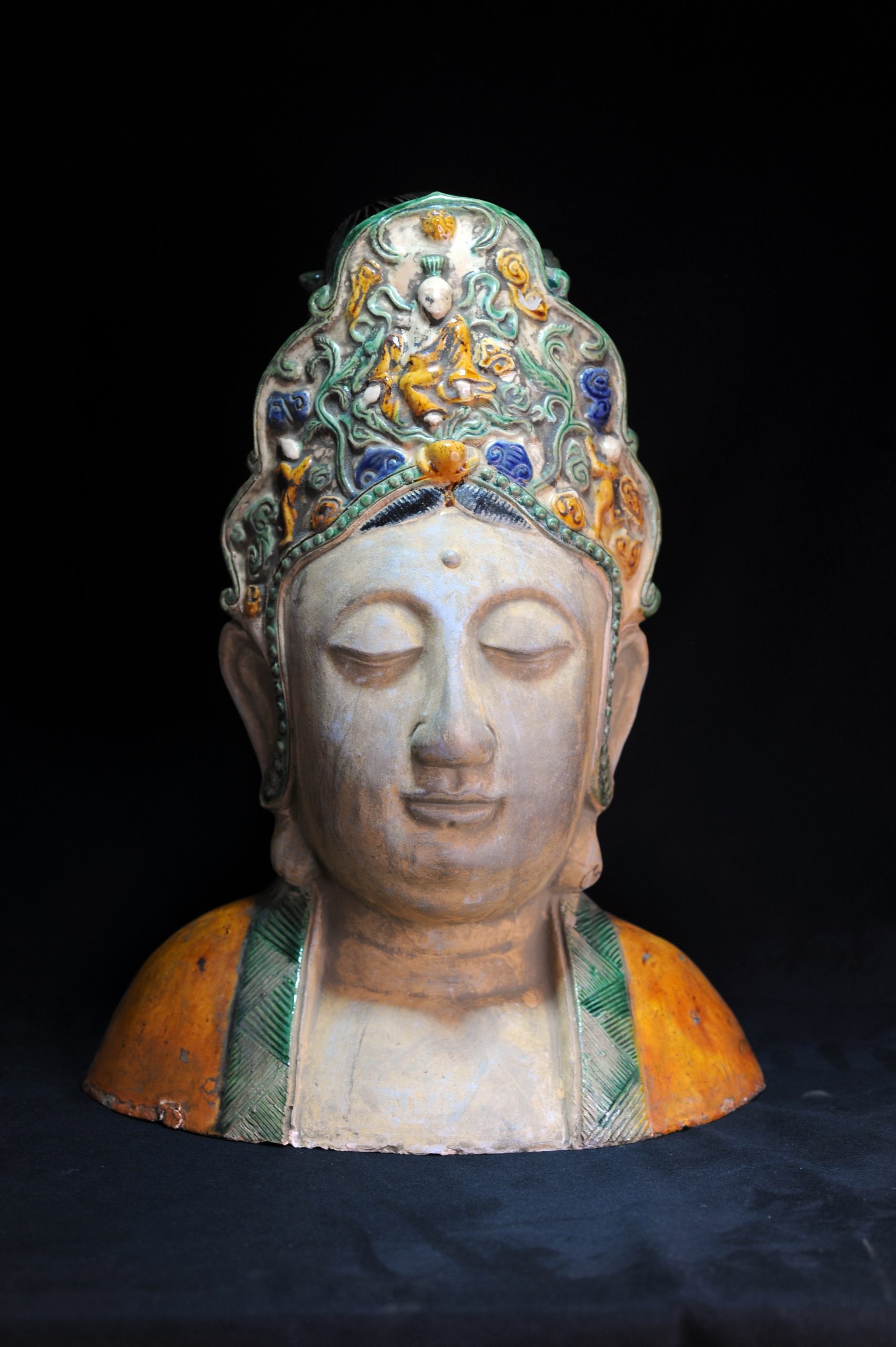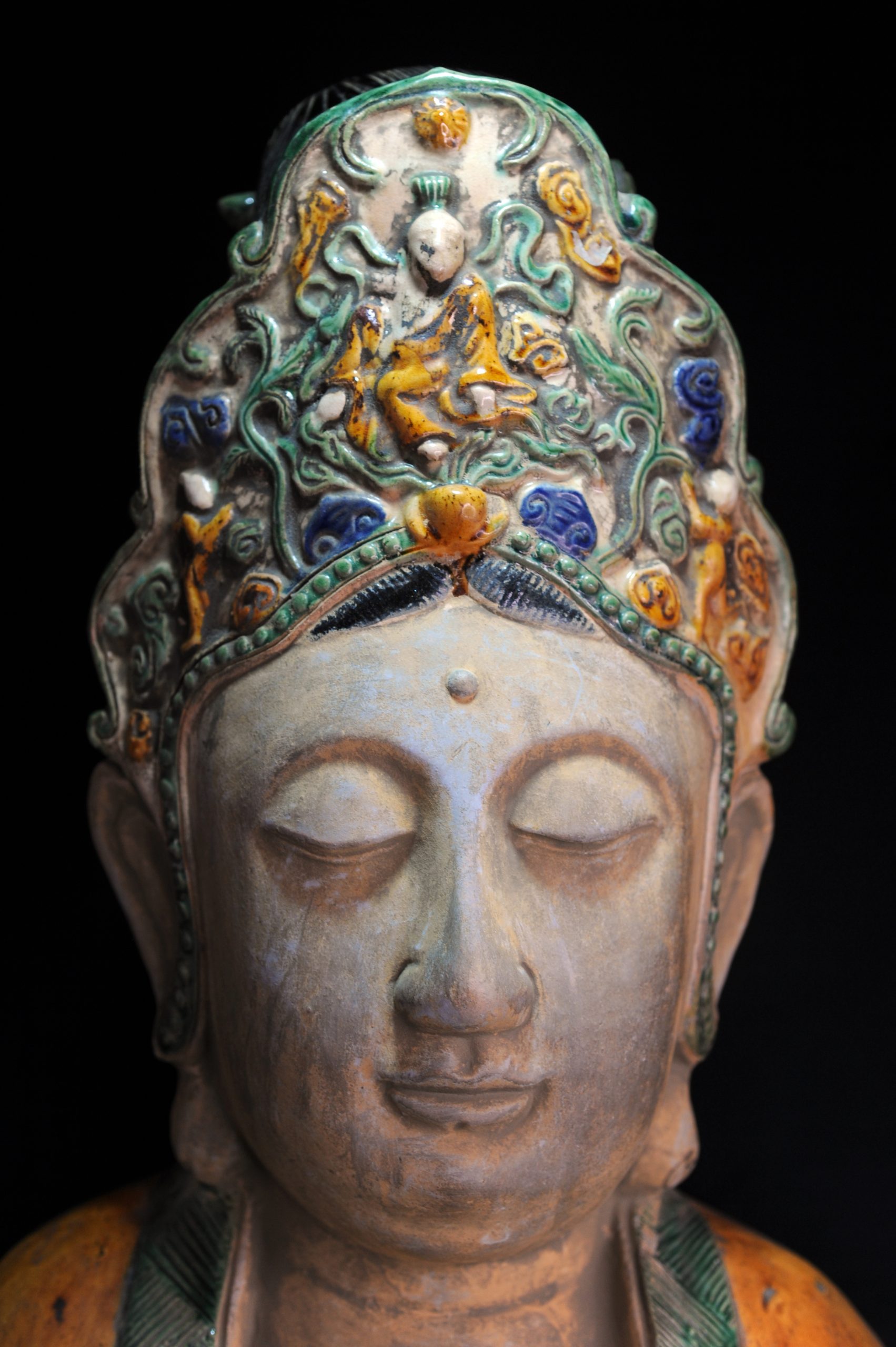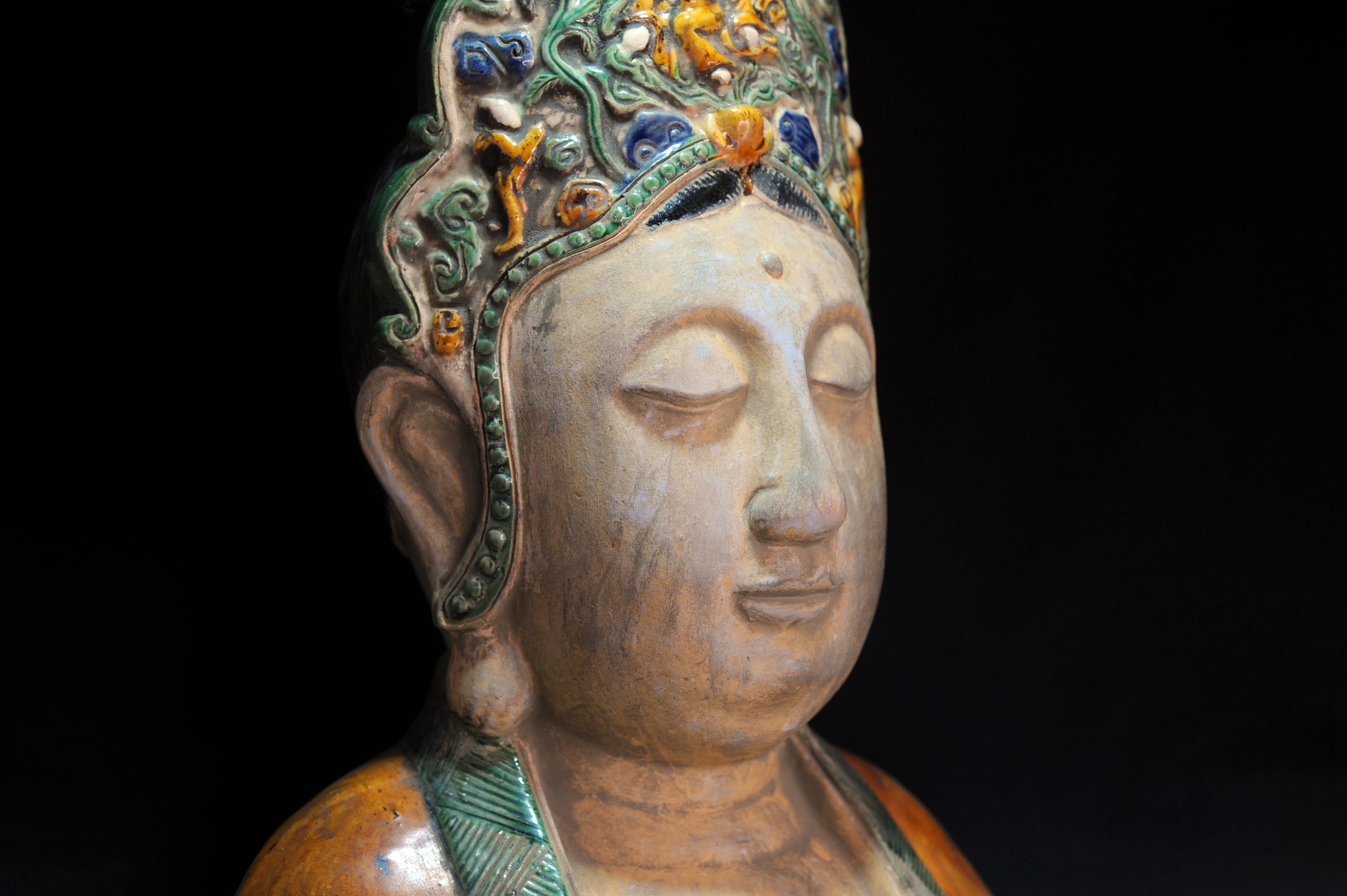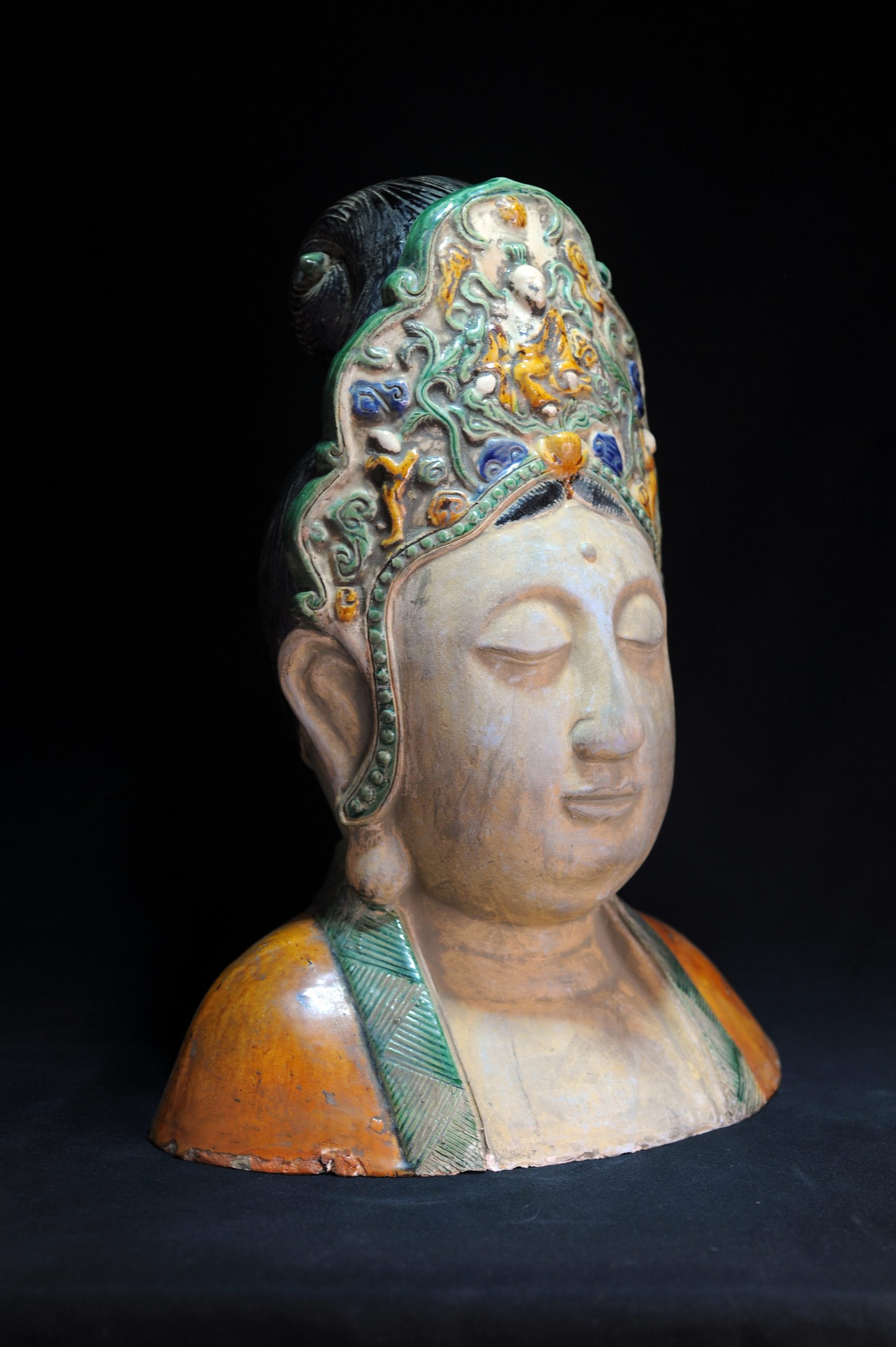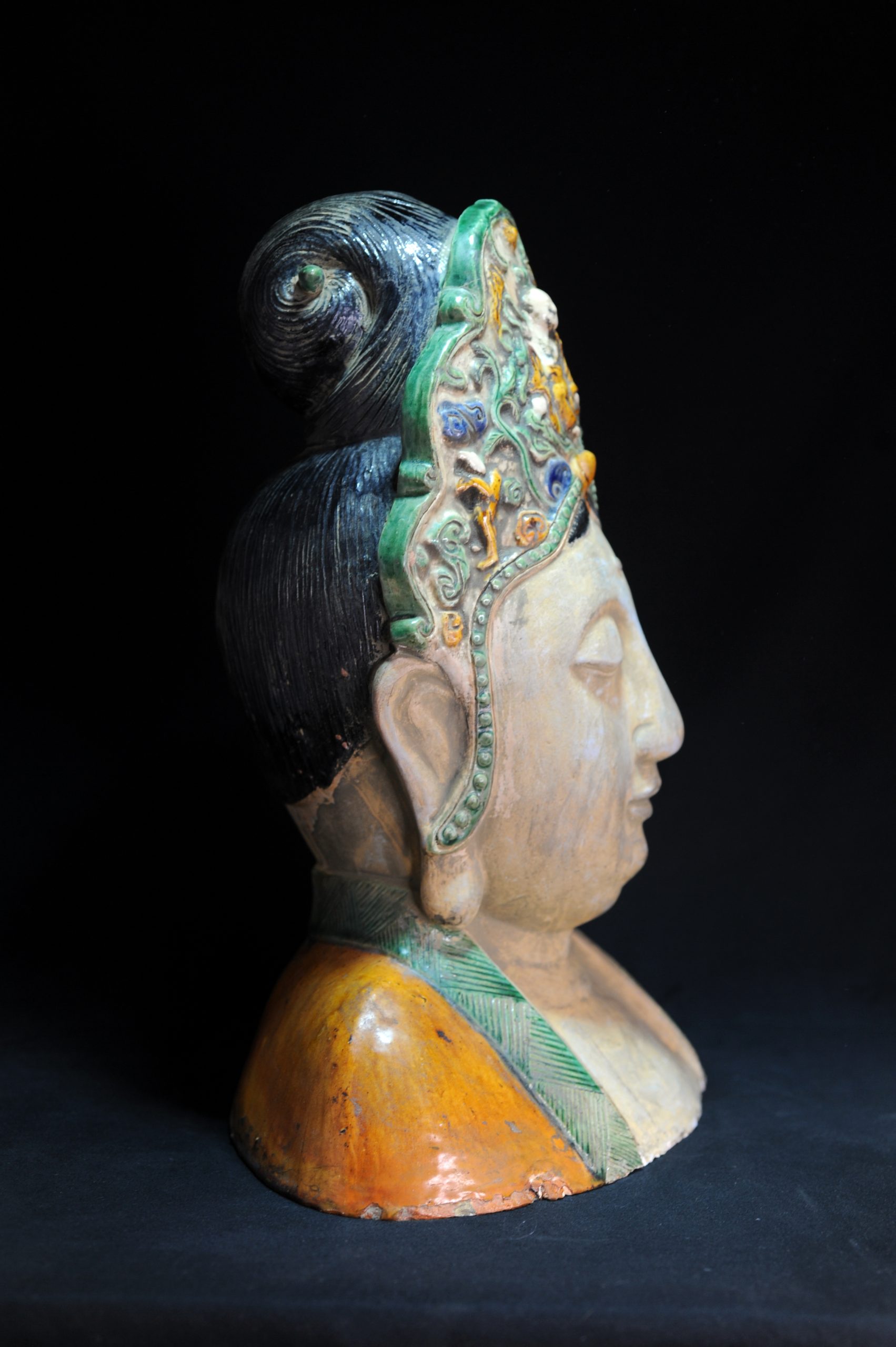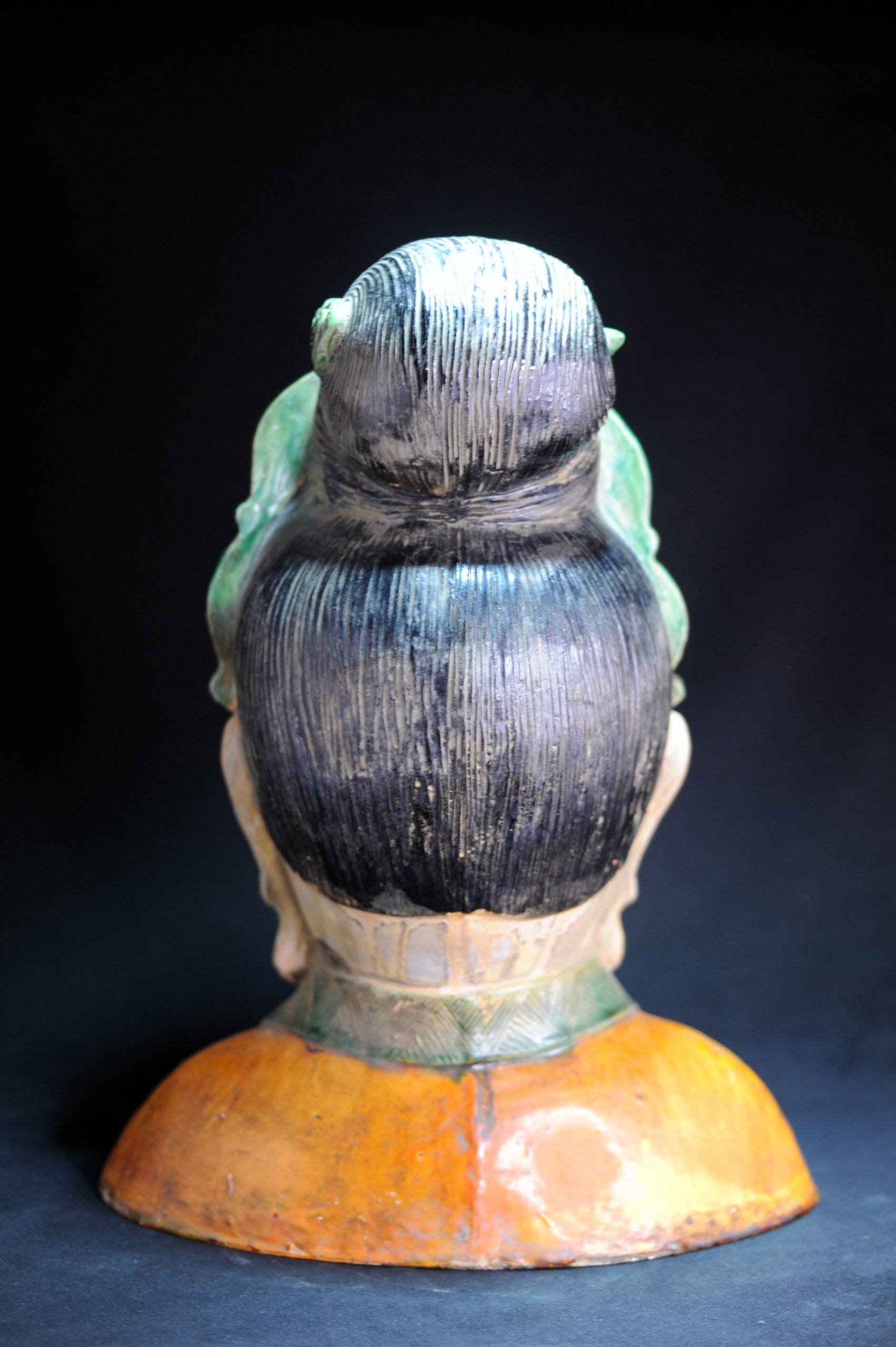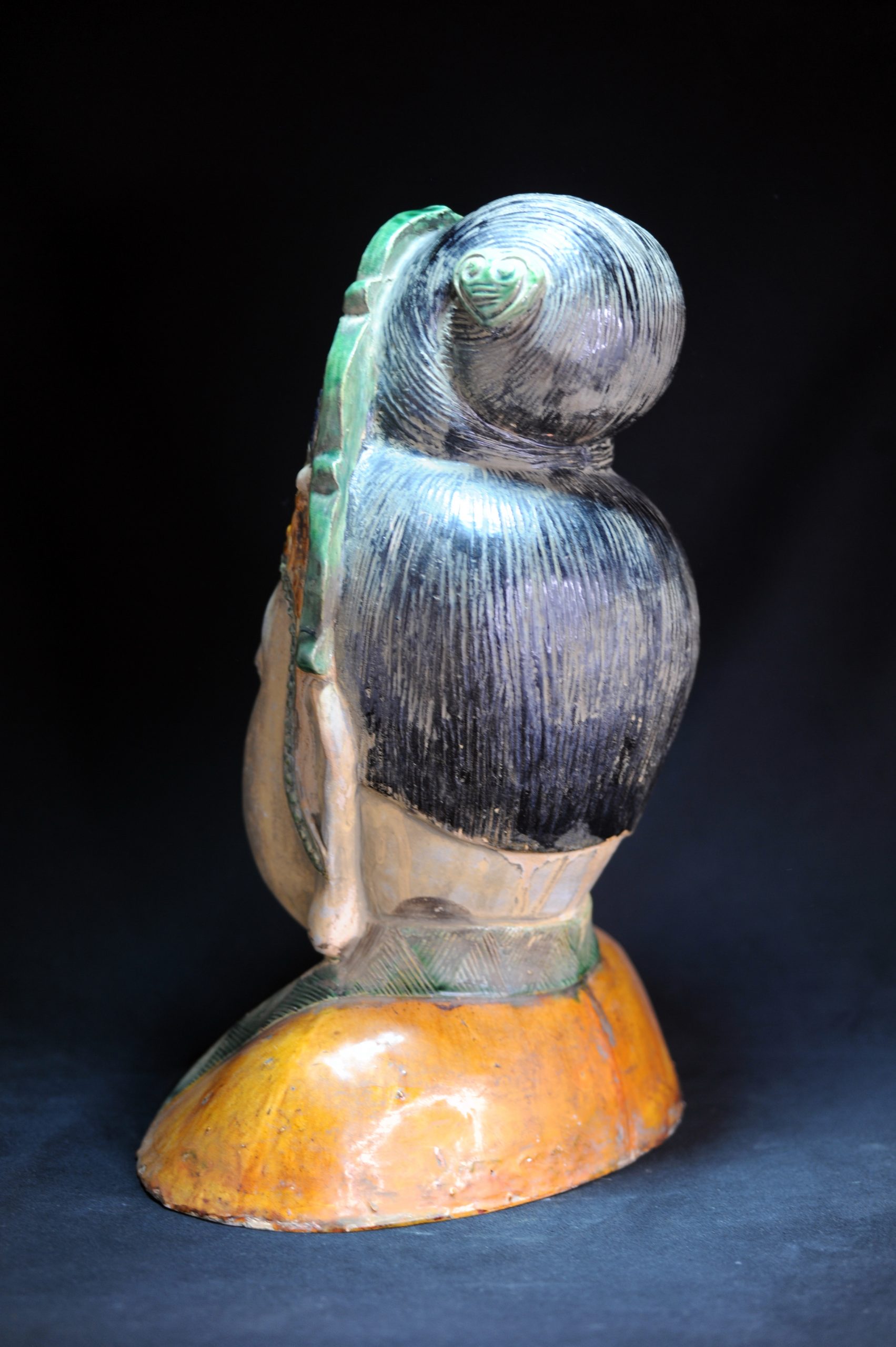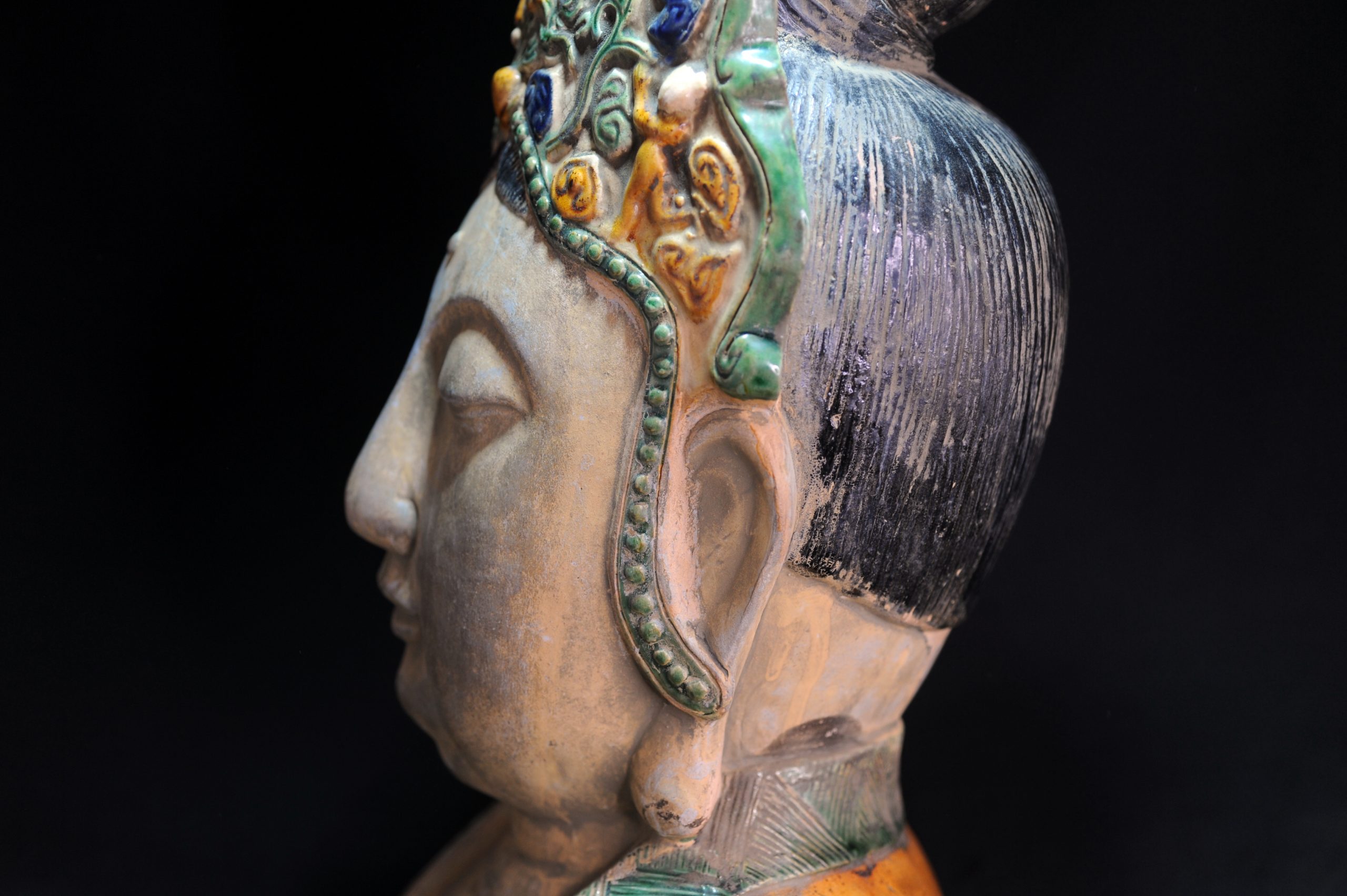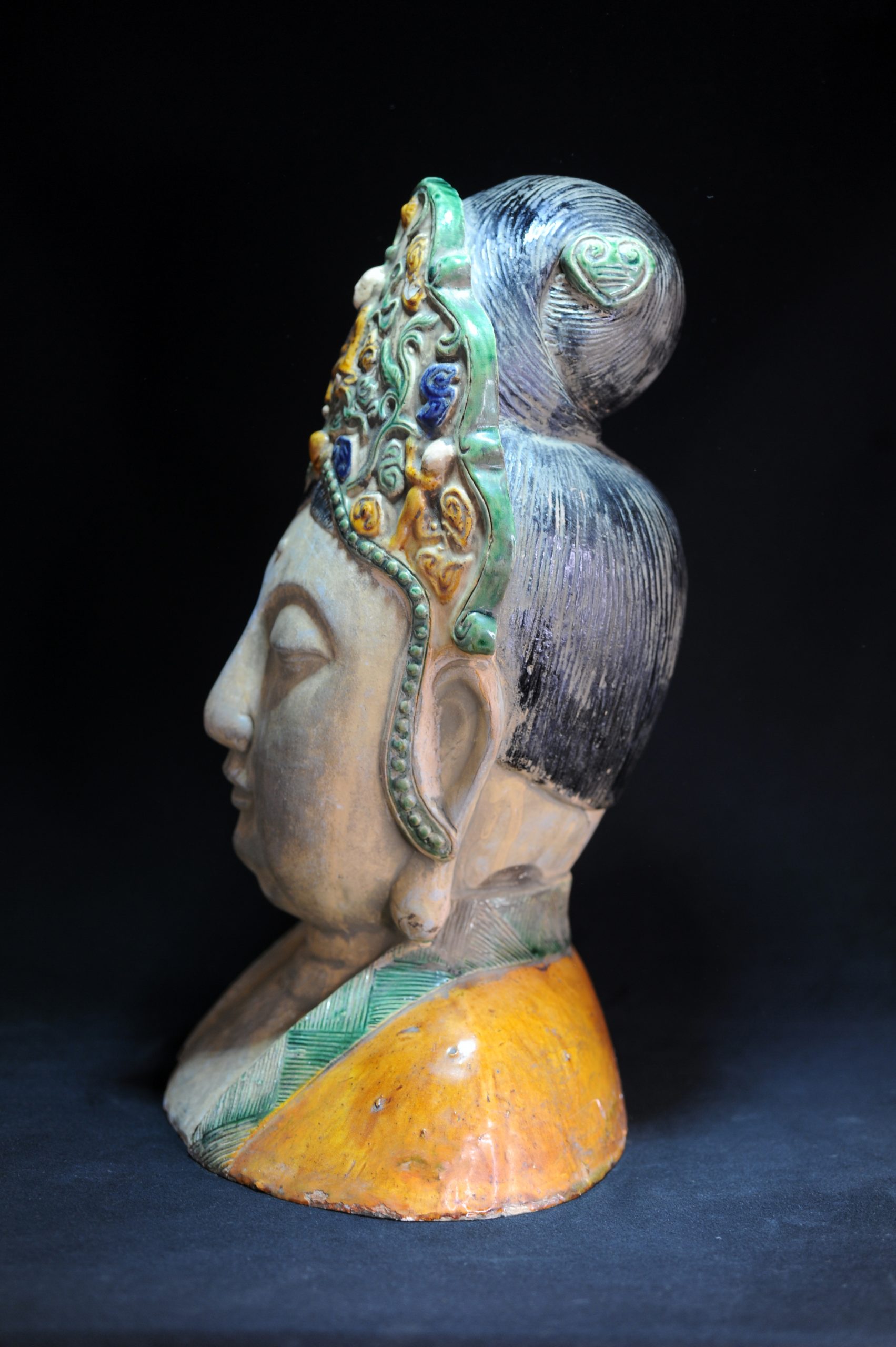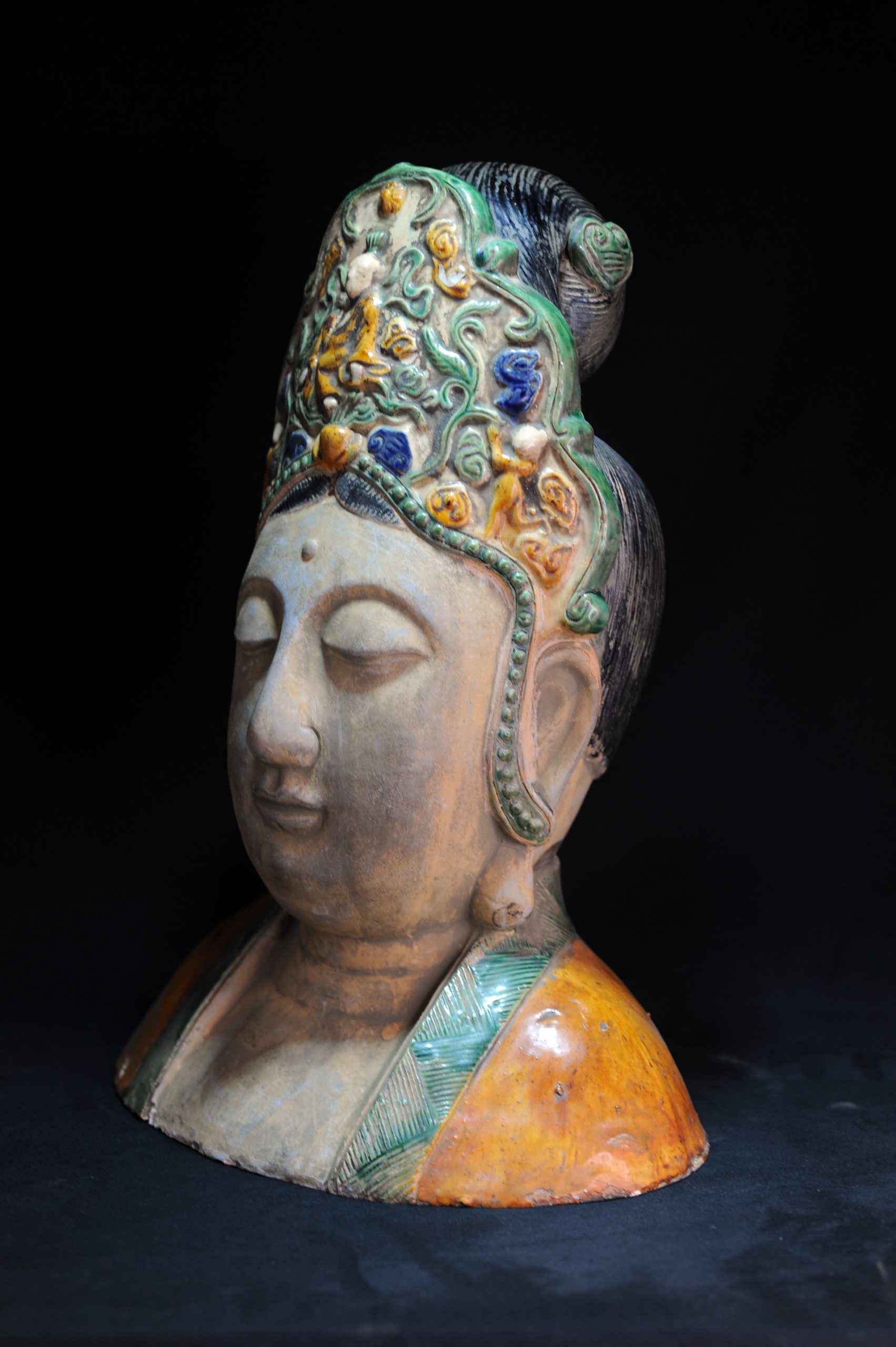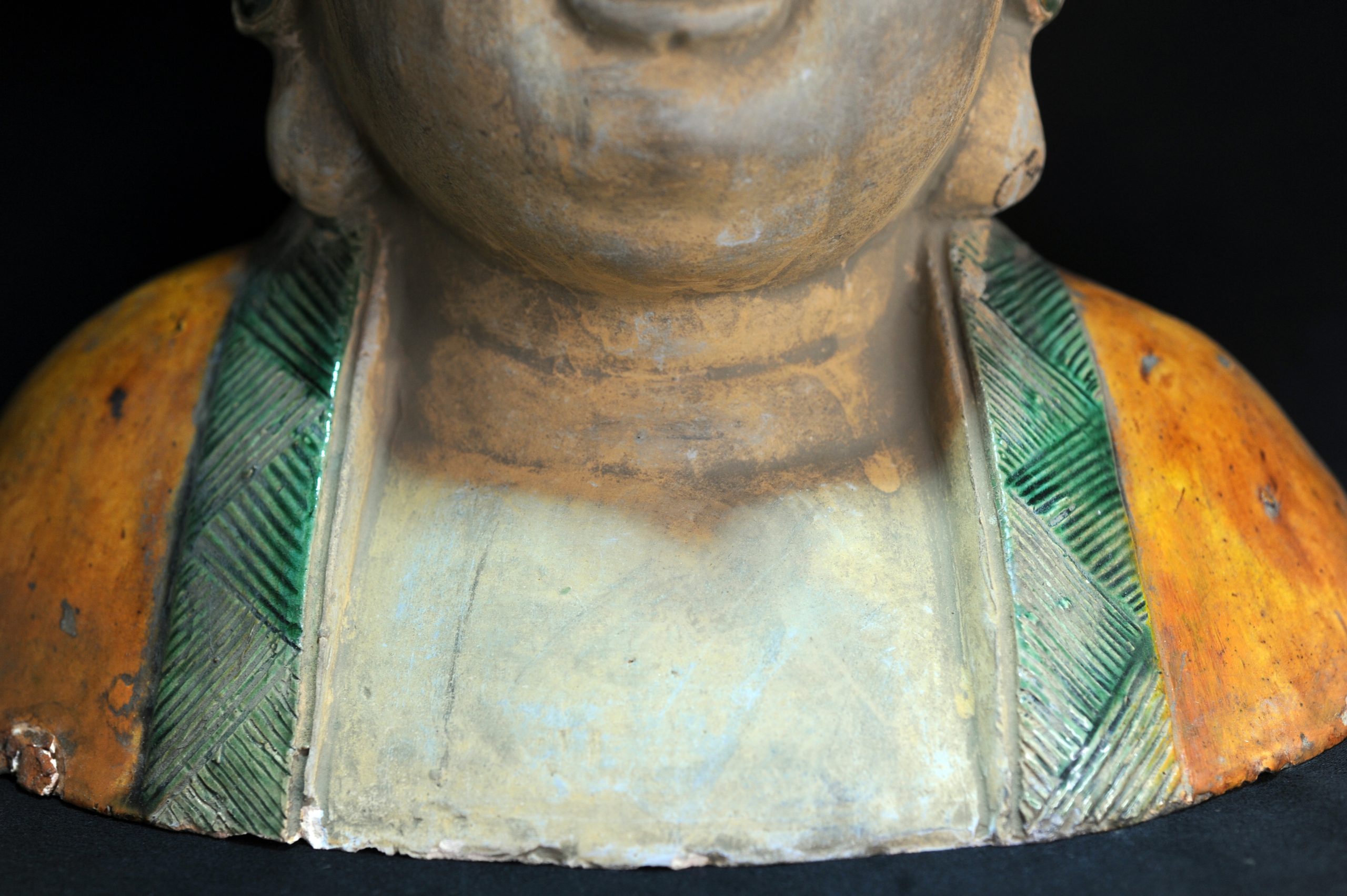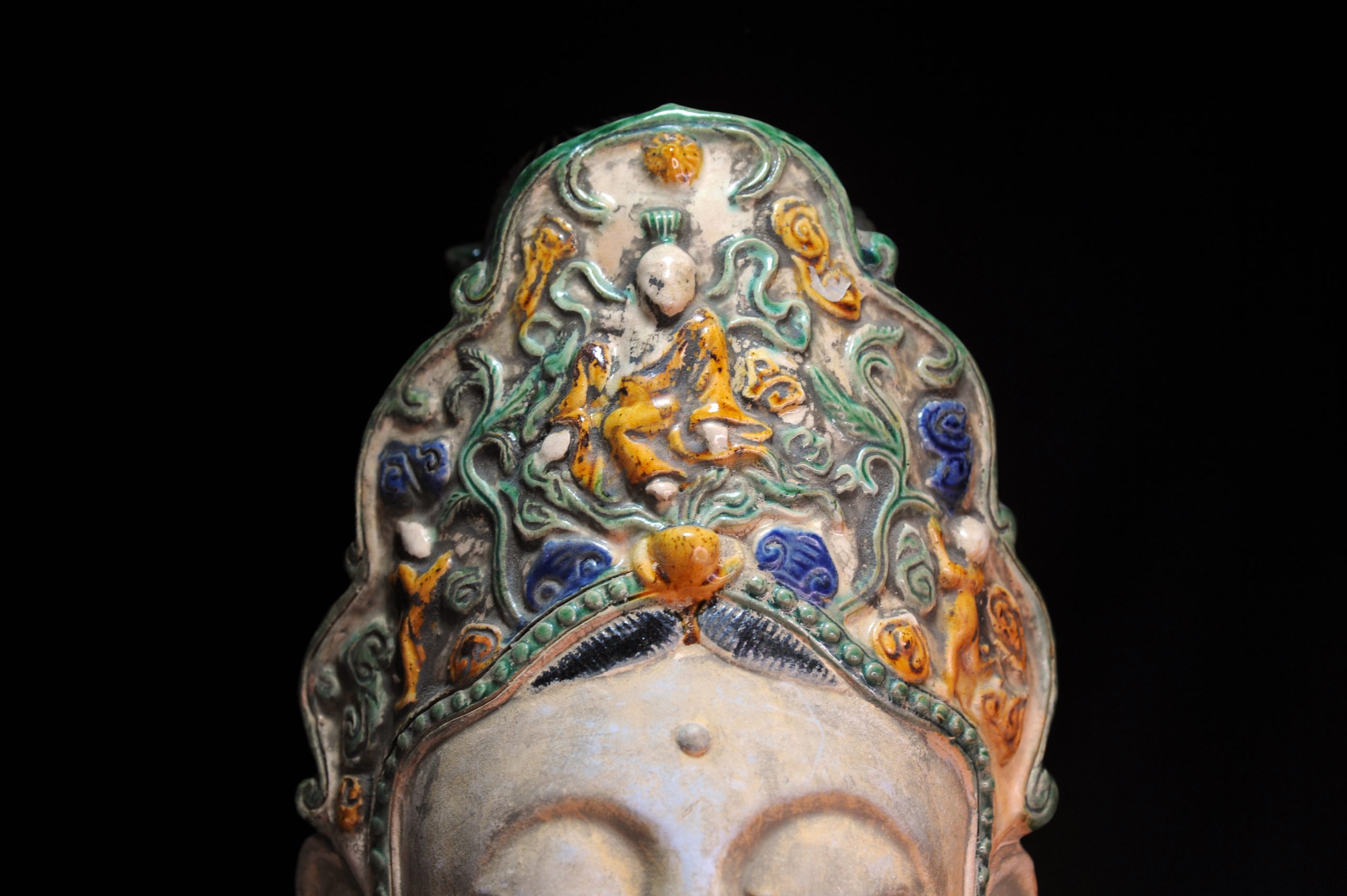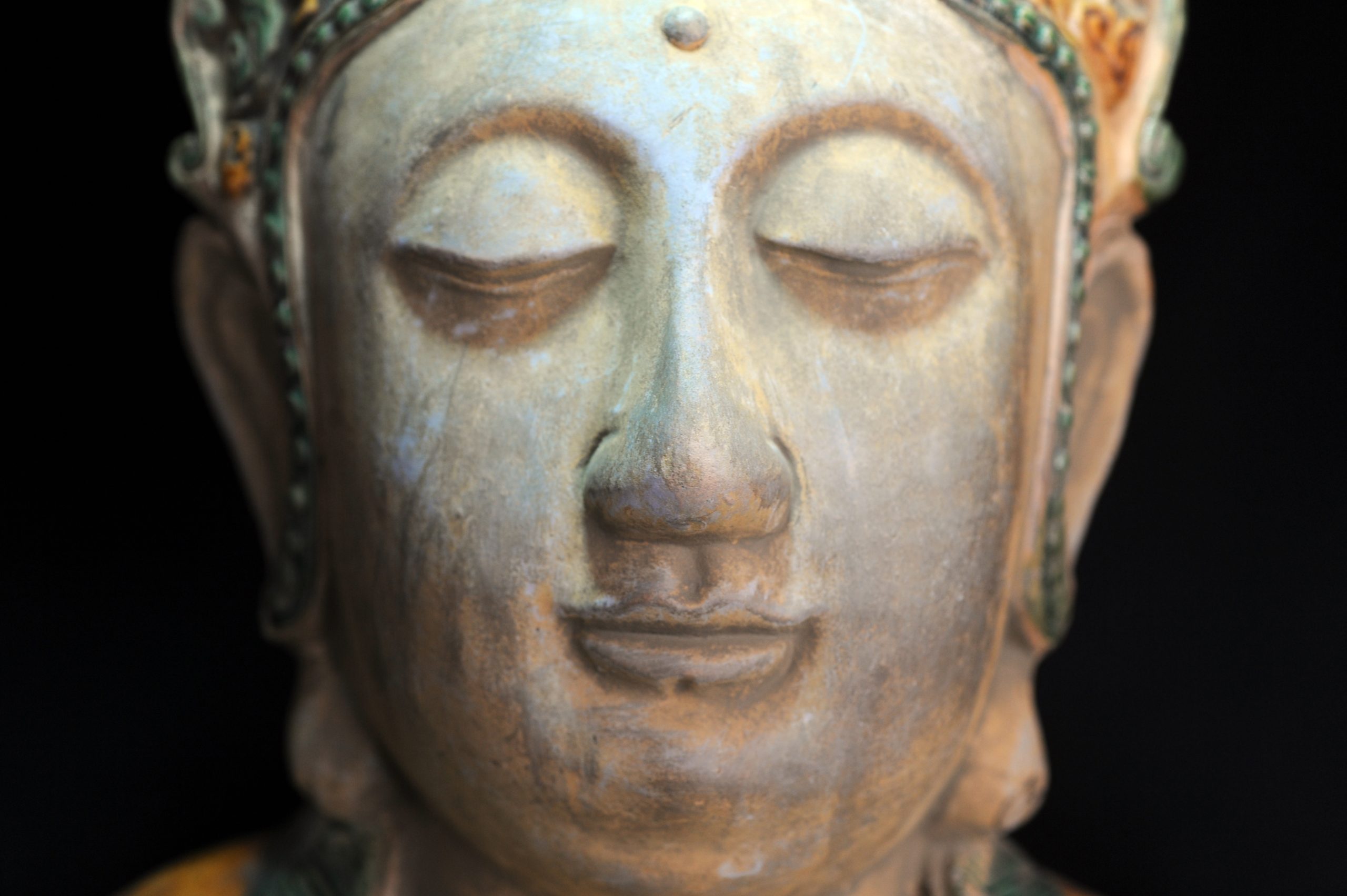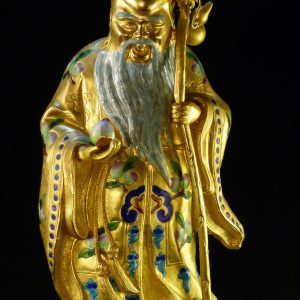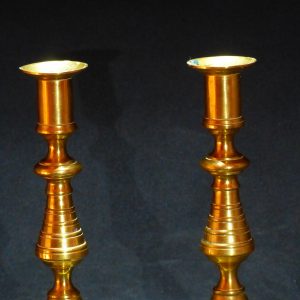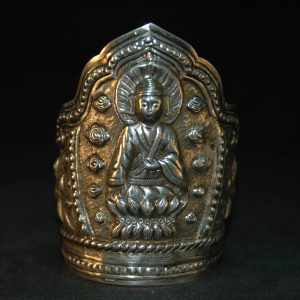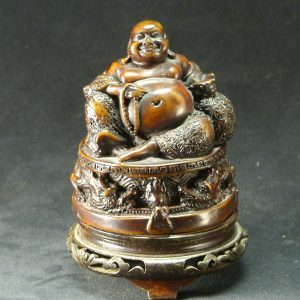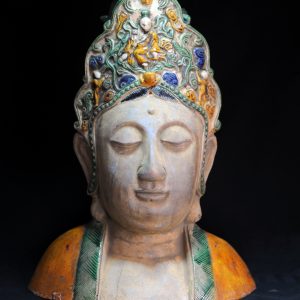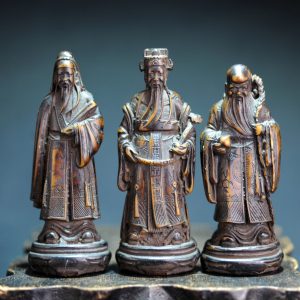Description
唐三彩 观音大士菩薩 佛造像
佛头,面呈椭圆,头梳高髻。高髻前有一尊小化佛,象征观音受业于阿弥陀佛。
参考:佳士得 23493
重要中國家具及工藝精品
拍品 834
A VERY RARE MASSIVE PAINTED STUCCO HEAD OF A BODHISATTVA
Another Property
明十六世紀 泥塑彩繪菩薩頭像
MING DYNASTY, 16TH CENTURY
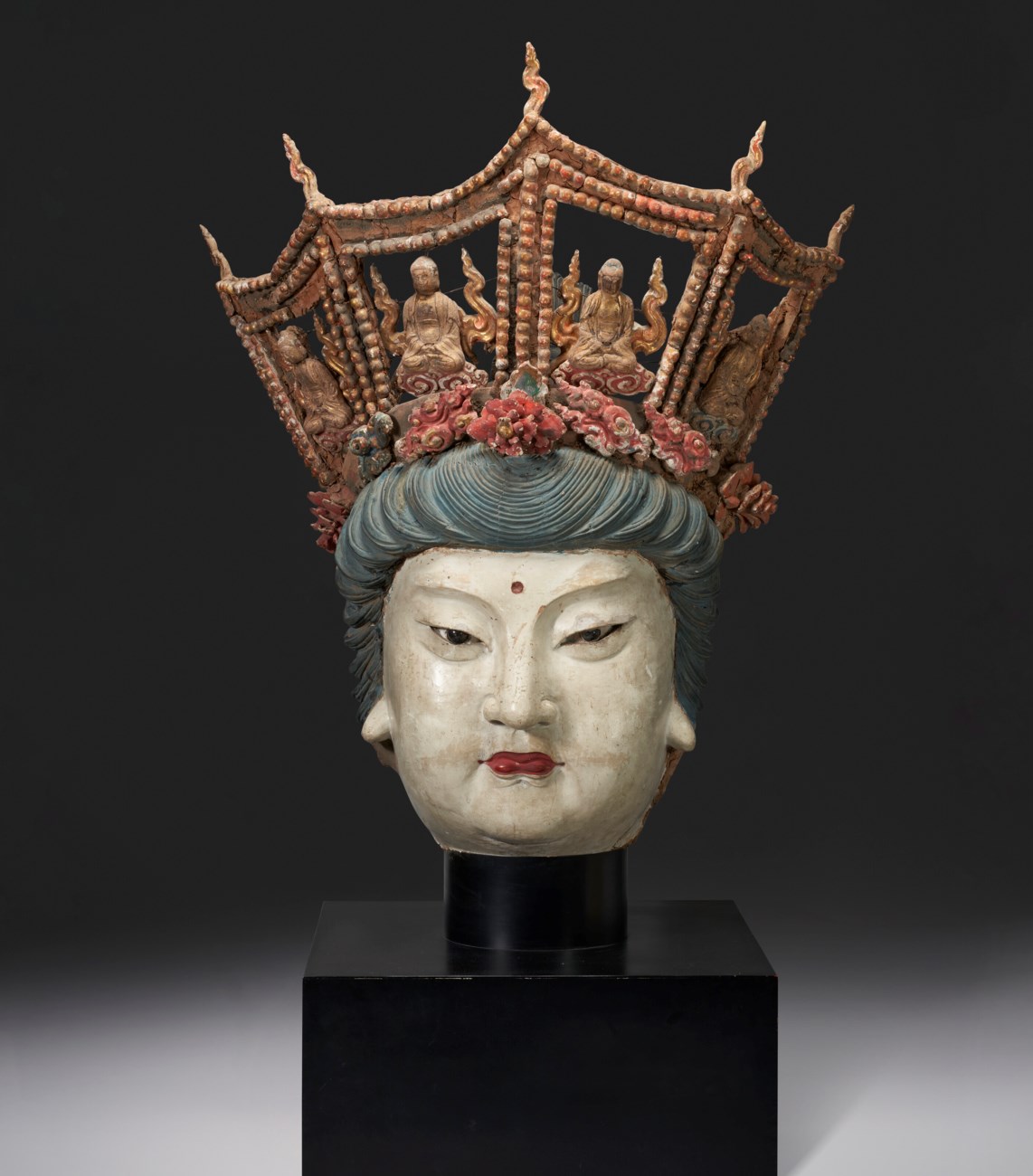
估價:美元 15,000 – 美元 25,000
細節
明十六世紀 泥塑彩繪菩薩頭像
38 ½ in. (97.8 cm.) high, black metal base
出版
《懷古堂》,紐約, 2000年春季刊,頁228-9,編號75
展覽
紐約,懷古堂,「 Realms of Faith」,2000年3月18日-4月15日
狀況報告
– 臉部若干區域的彩繪稍經修飾
– 寶冠火焰、三佛首及少許凸出紋飾之若干區域經重黏
– 頭髮、頸部右側及一些凸出紋飾有纖幼裂紋
– 一眉及左耳有淺細磕;凸出紋飾有正常微磕及細磕
– 彩繪有正常缺損及淺剝落;描金有磨損
– 正常的表面磨損,尤以寶冠明顯
拍品專文
This monumental head of a bodhisattva was made with clay and lime combined with a binding material applied over a wood core, and was then colored with mineral pigments. The ease of working with these materials allowed artisans to create larger-scale sculptural works such as this magnificent head.
Buddhist stucco figures were popular from the Tang dynasty onwards, and many spectacular examples have been found in temples in Shanxi province, known for its vast quantity of Buddhist monasteries. Compare a Tang dynasty stucco bodhisattva illustrated in Shanxi foujiao caisu (Buddhist Sculpture of Shanxi Province), Beijing, 1991, pl. 1. The present bodhisattva head relates to these earlier Tang prototypes in the rendering of the hair and elaborate crown, and finely-modeled features.
这尊宏伟的菩萨头像由粘土和石灰与结合材料混合,涂抹在木质核心上,最后用矿物颜料着色。使用这些材料的便利性使工匠能够创作出如此宏大的雕塑作品,正如这尊精美的头像所示。
佛教灰塑雕像自唐代起开始流行,许多壮丽的例子已在山西省的寺庙中被发现,山西以其大量的佛教寺院闻名。可以与《山西佛教雕塑彩塑》一书中所展示的唐代灰塑菩萨像进行对比(《山西佛教雕塑》,北京,1991年,图版1)。目前的菩萨头像在发型、精致的冠冕和精细塑造的面部特征上,继承了这些早期唐代原型的风格。
参考:苏富比
Important Chinese Art
15 三月 2017 • 紐約
拍賣編號: N09662
拍品 545 宋 / 元 木雕彩塑觀音首像
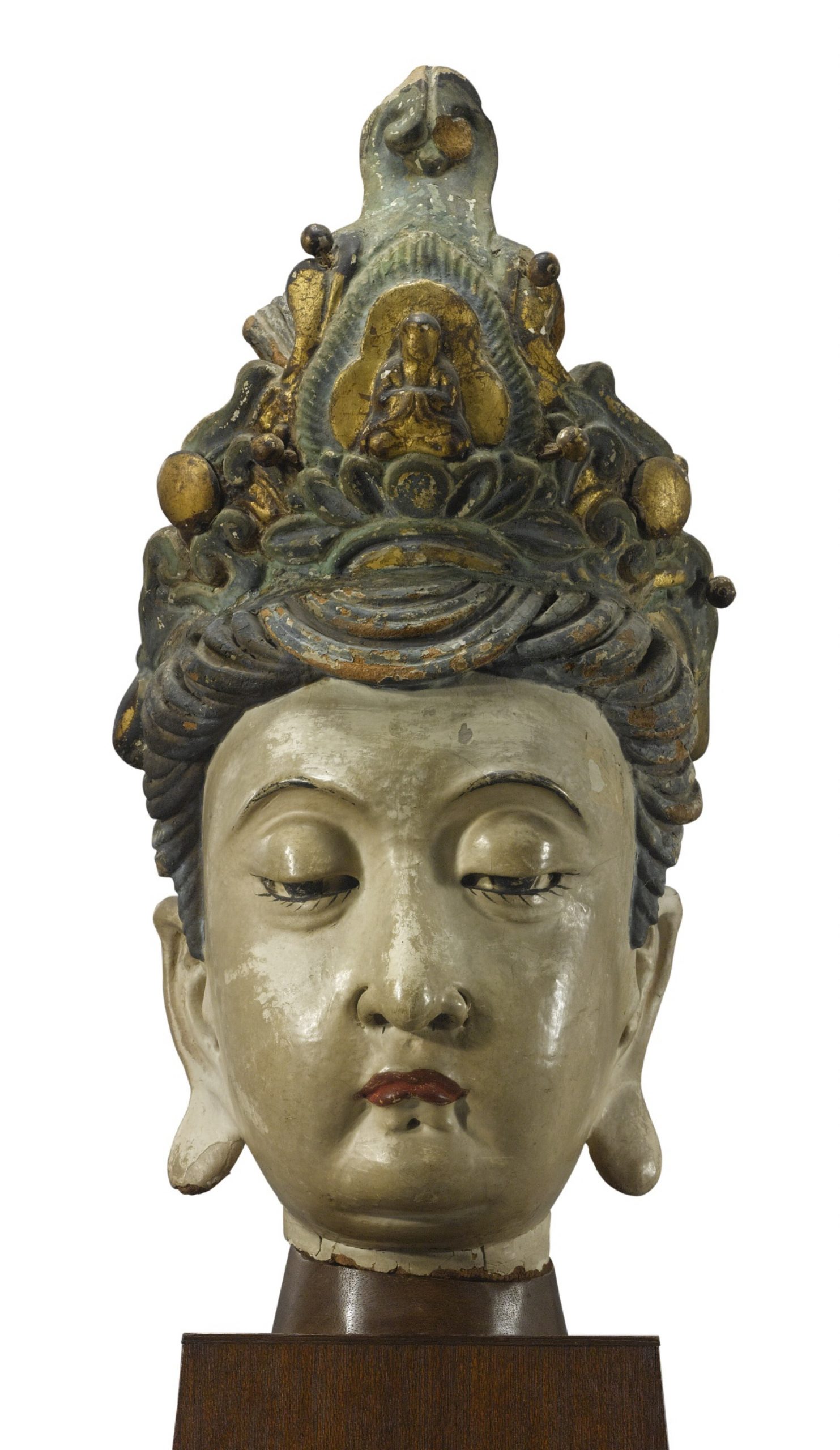
估價 20,000 – 30,000 USD
已售出 25,000 USD
描述
stucco
Height 18 in., 45.7 cm
well-carved, the face detailed in black and red pigment against an ivory-white ground, the eyes downcast beneath arched brows, the red lips slightly downturned in thoughtful mien, softened by the full cheeks to either side and dimpled chin below, the blue-painted hair swept up in an elaborate chignon, secured by a foliate crown centered by a gilded figure of Amitaba Buddha, wood stand (2)
來源
Nagatani, Inc, 1973年
紐約佳士得2000年3月21日 ,編號207
参考:佳士得
11 6月 2019 | 現場拍賣 17457
亞洲藝術
拍品 179 約十四世紀 彩繪泥雕觀音頭像 歐洲私人珍藏
TETE DE GUANYIN EN STUC POLYCHROME
PROPERTY FROM AN IMPORTANT EUROPEAN COLLECTION
CHINE, CIRCA XIVEME SIECLE
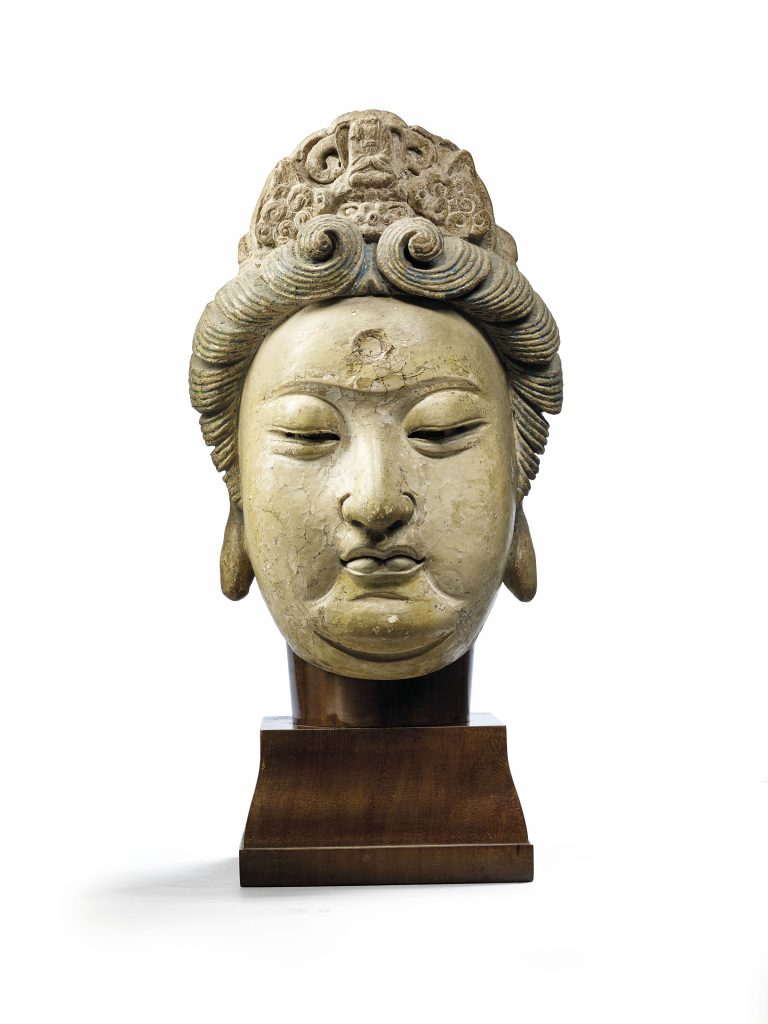
成交價 EUR 25,000
估價 EUR 20,000 – EUR 30,000
約十四世紀 彩繪泥雕觀音頭像
CHINE, CIRCA XIVEME SIECLE
來源
Acquired from a Parisian dealer by the father of the present owner, who was an important Chinese porcelain collector in Belgium, circa 1930.
Appraised by Michel Beurdeley, Paris, in 1979 (by repute).
來源:
藏家父親於1930年間購自巴黎古董商
傳於1979年經法國古董商Michel Beurdeley鑑定
歐洲私人珍藏
Hauteur: 38 cm. (15 in.), socle en bois
拍品專文
A POLYCHROME STUCCO HEAD OF GUANYIN
CHINA, CIRCA 14TH CENTURY
参考:苏富比
Literati / Curiosity II /
04 四月 2016 • 香港
拍品 2885
唐 石雕加彩菩薩頭像
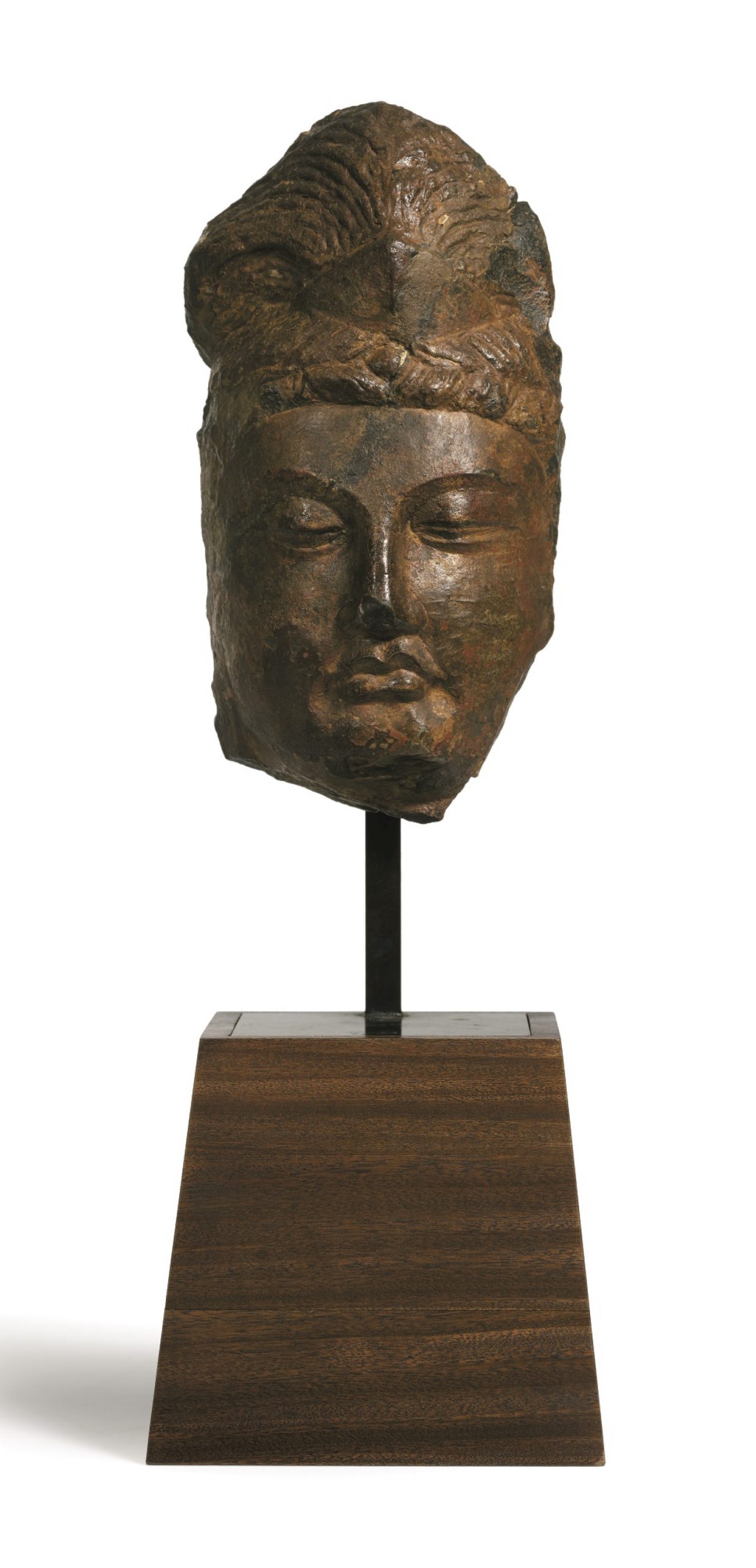
估價 900,000 – 1,200,000 HKD
描述
Stone
23 公分,9 英寸
the slender face handsomely carved with large downcast eyes and defined brows flanking a refined nose above full lips, the thick hair pulled back and piled into a loose chignon behind a simple pointed crown, richly patinated to ochre and reddish-brown tones, mounted on a metal and wood stand
來源
歐洲舊藏
拍品資料及來源
此件石雕菩薩乃早唐雕塑之經典,匯集當朝風格於一體:厚實髮髻、潤頰豐頦、彎眉垂目、挺鼻纖秀、唇瓣飽滿、嘴角微揚,威嚴慈悲,耳長呼應菩薩道行地位。
雕刻風格呈現菩薩入世度人,解救眾生之慈懷,低目微垂、唇間微笑,暗示神祉與俗世之緊密牽連,隨觀者角度變化,可見菩薩表情隨之而變,展現石匠神工奇技。唐代初期,佛教深植民間生活,造像已漸漢化,曾經深刻影響前朝石雕的印度風格,此時已不復見。
參考四件近類比例風格之唐代石雕佛頭,載於 Osvald Siren,《Chinese Sculpture: From the Fifth to the Fourteenth Century》,紐約,1925年,圖版465。另一件石雕藏於東京國立博物館,展出於《中国の石仏 : 荘厳なる祈り》,大阪市立美術館,大阪,1995年,編號64。還有一件佛像,頭冠類同此件拍品,曾展於《China Cultuur Vroeger en Nu》,Centrum voor Kunst en Cultuur,根特,1979年,編號313。
参考:苏富比
Literati / Curiosity II /
04 四月 2016 • 香港
拍品 2871
隋 石灰石加彩菩薩頭像
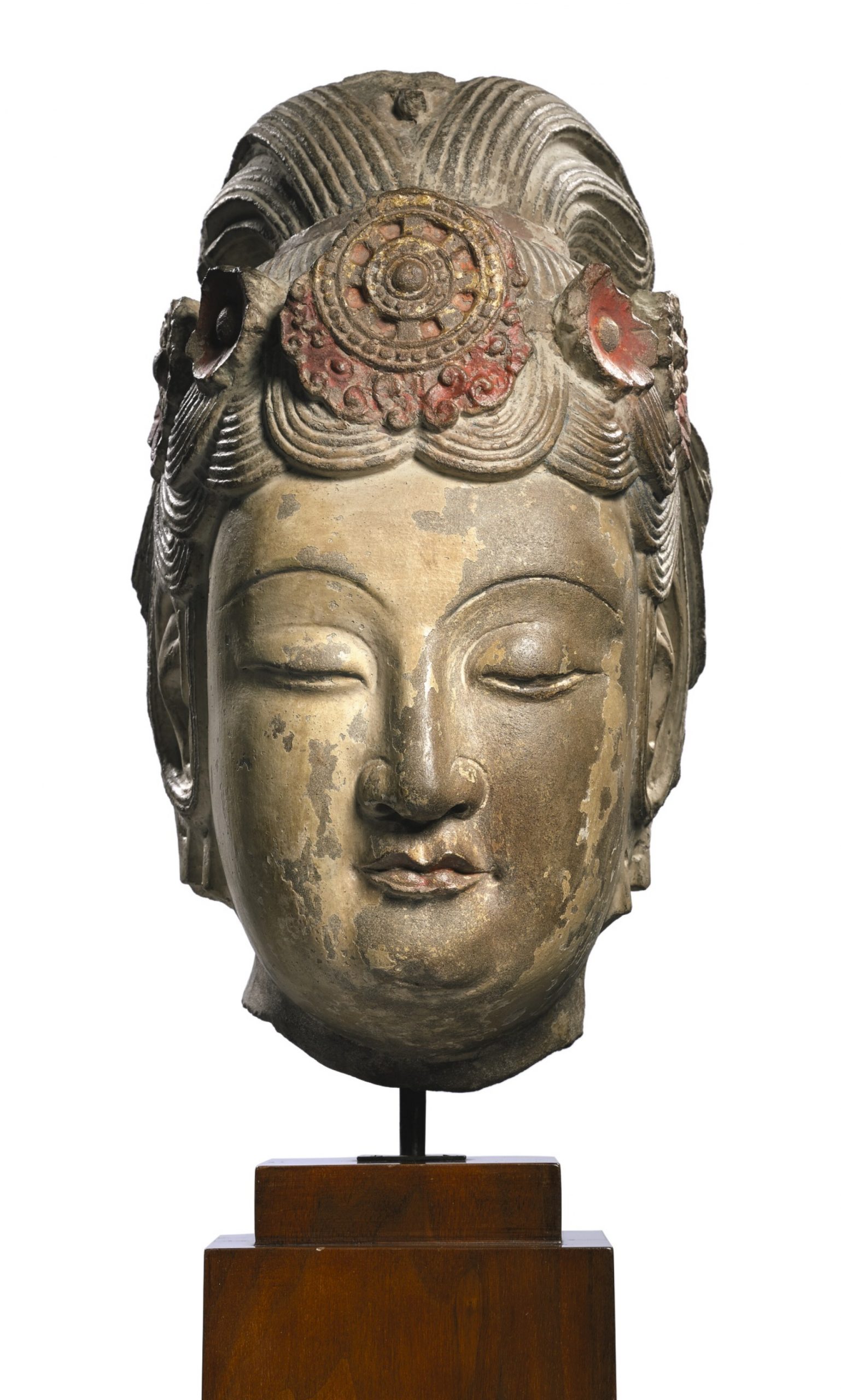
隋 石灰石加彩菩薩頭像
估價 3,500,000 – 4,500,000 HKD
已售出 7,280,000 HKD
描述
Limestone
36 公分,14 1/4 英寸
the softly rounded face gracefully carved and framed by arched brows extending to a refined aquiline nose, eyes gently cast down above full cheeks and a delicately formed mouth, the gaze half closed in an expression of quiet contemplation, the elegantly coiffed hair in layers of looped sections with thick strands trailing around the well-formed ears over pierced elongated lobes and gathered high into a double chignon at the crown, the hairstyle decorated with a Dharma wheel painted with traces of gilt above a bed of crimson-painted curlicues, accompanied by futher carved florets to either side, the stone smooth with areas of darker patination, wood stand
來源
山中商會,紐約,1943年
展覽
山中商會,《Collection of Chinese and Other Far Eastern Art Assembled by Yamanaka & Company, Inc. Now in Process of Liquidation Under the Supervision of the Alien Property Custodian of the United States of America》,紐約,1943年,編號372
拍品資料及來源
石雕菩薩頭像,雕工嫻熟細膩,展現菩薩莊嚴華貴,仁慈沉靜,屬隋石雕工藝之最。菩薩面容纖腴合度,鳳眼低垂,秀眉與鼻樑相連成一道柔弧,長髮後挽成高髻,綴以雲頭法輪寶冠,萃集隋代經典佛相於一體。
參考波士頓博物館藏兩尊隋代石灰石菩薩立像,其一刊於 Osvald Siren,《Chinese Sculpture》,卷2,紐約,1970年,圖版315 A,另一件載於《中國美術全集.雕塑編》,卷4:隋唐雕塑,北京,1988年,圖版12,據傳1909年出自西安某古寺,面部雕刻風格自然逼真,華美寶冠均與此尊相類。並比較另一尊菩薩立像,頭冠綴法輪,錄於松原三郎,《中國佛教雕刻史論》,東京,1995年,卷2,頁580。
参考:佳士得
9 12月 2014 | 現場拍賣 3608
亞洲藝術
拍品 334 元 石雕观音头像
RARE ET IMPORTANTE TETE DE GUANYIN EN CALCAIRE
THE PROPERTY OF A FRENCH COLLECTOR
CHINE, DYNASTIE YUAN (1271-1368)
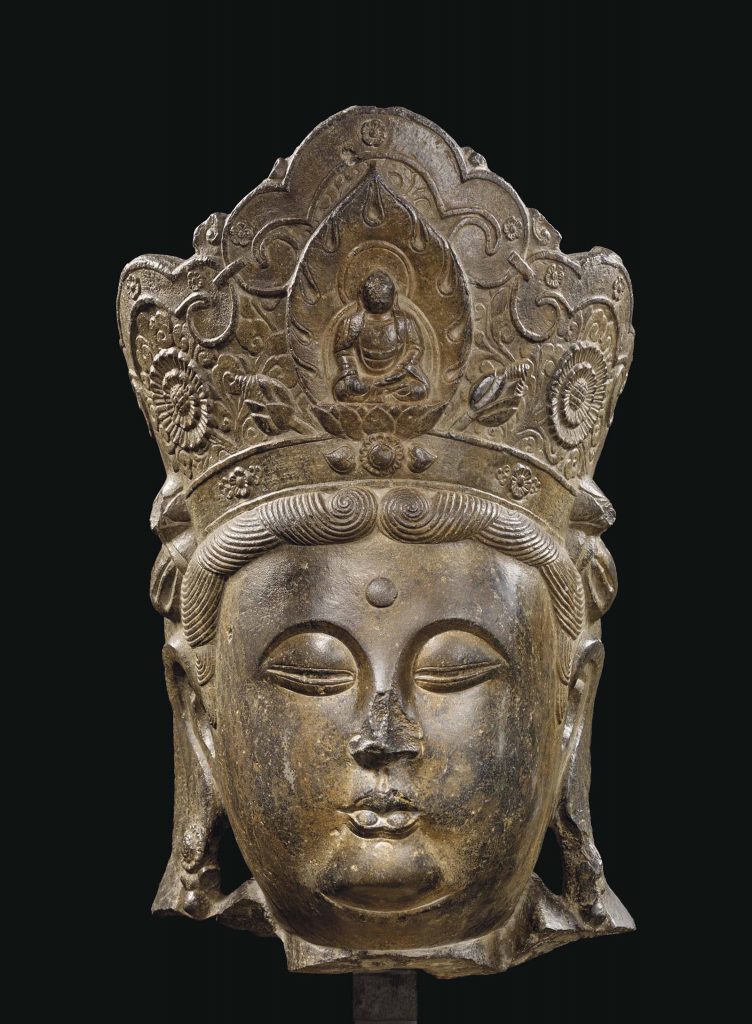
成交價 EUR 349,500
估價 EUR 300,000 – EUR 500,000
細節
RARE ET IMPORTANTE TETE DE GUANYIN EN CALCAIRE
CHINE, DYNASTIE YUAN (1271-1368)
The oval face is sculpted with a serene and meditative expression. It displays strongly arched eyebrows, over almost closed eyes, connected to the nose by a narrow bridge. His forehead is adorned with the urna. The sunken, almost almond-shaped eyes are have heavy eyelids, which reinforces the linear effect produced by the eyebrows. The meticulously carved heart-shaped lips suggest a faint smile, and the chin is accentuated by an incision. Both ears are executed with elongated earlobes decorated with small rosettes. Various curling locks frame the face while the rest is combed backwards in a chignon on top of his head, and is kept together by a high, scalloped-shaped crown, which is carved in shallow relief with three arches above a lotus flower flanking a minute figure of Buddha Shakyamuni. The latter is seated on a lotus base in front of a flaming mandorla. A pair of knotted ribbons is attached to both sides of the crown with some small streamers falling down behind the ears.
22½ in. (57 cm.) high, stand
來源
Acquired at auction at Drouot (sale curated by Michel Beurdeley),
Paris, in the 1970s.
出版
John Walker,Experts Choice 1000 Years of the Art Trade, Seventh
International Exhibition Presented by C. I. N. O. A. Virginia
Museum of Fine Arts, Richmond, Virginia, Stewart, Tabori &
Chang Publishers, New York, 1983, page 21.
展覽
La Biennale des Antiquaires, September-October 1980.
Virginia Museum of Fine Art, 1983.
拍品專文
A HIGHLY IMPORTANT LIMESTONE HEAD OF GUANYIN
CHINA, YUAN DYNASTY (1271-1368)
拍品專文
This magnificent and large head presents the bodhisattva of Compassion and Mercy. The iconography of the god was originally created on Indian soil and brought to China by monks at the beginning of the Christian era. In the early phase of Chinese Buddhism stone and bronze examples of the god of Compassion were following these Indian iconographic treatises by depicting him as a male god. By the end of the Tang period (618-907) the depiction of Avalokiteshvara or in Chinese Guanyin had gradually become feminized to reach a climax during the Song dynasty (960-1279), when the majority had acquired a definite female appearance. During this period of transition the mercy aspect of the god was emphasized resulting in these stronger female features. The presented superb sculpted head shows the result of this development, which had become the hallmark for all Guanyin representations from now onwards.
This head surpasses in quality known examples in public institutes like the Rietberg Museum, Zurich (O. Siren, Chinese Sculptures in the von der Heydt Collection, Museum Rietberg, Zurich 1959, plate 57), Metropolitan Museum (O. Siren, Chinese Sculpture: From the Fifth to the Fourteenth Century, vol. II, SDI Publications, Bangkok 1998, plate 563 C), Wereldmuseum Rotterdam (De Schatten van het Wereldmuseum Rotterdam, Wereldmuseum Rotterdam 2000, p.39) and Musée Guimet.
参考:普林斯顿大学美术馆藏观音像
明弘治 | 三彩观音像
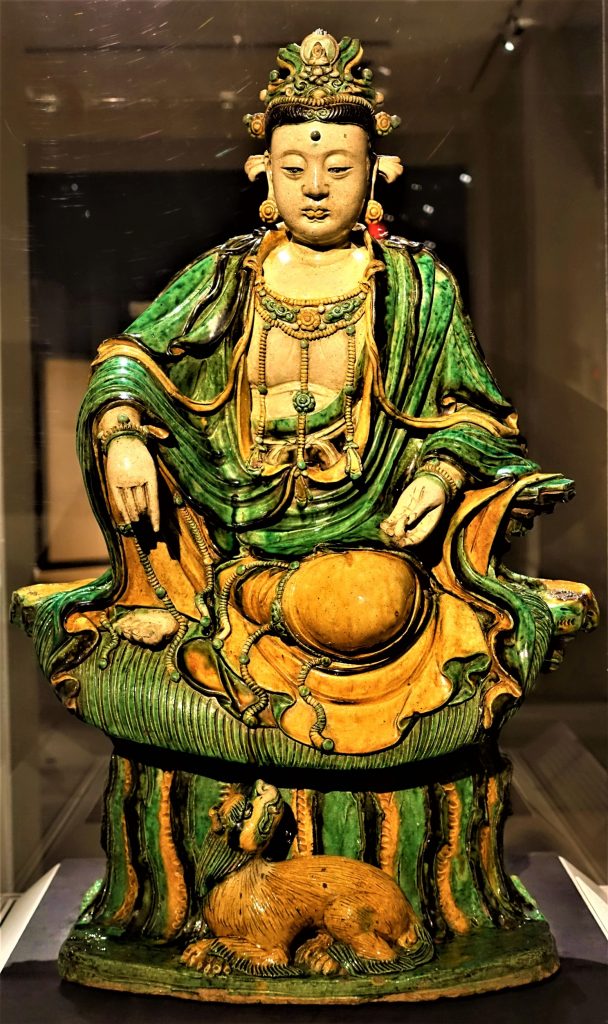
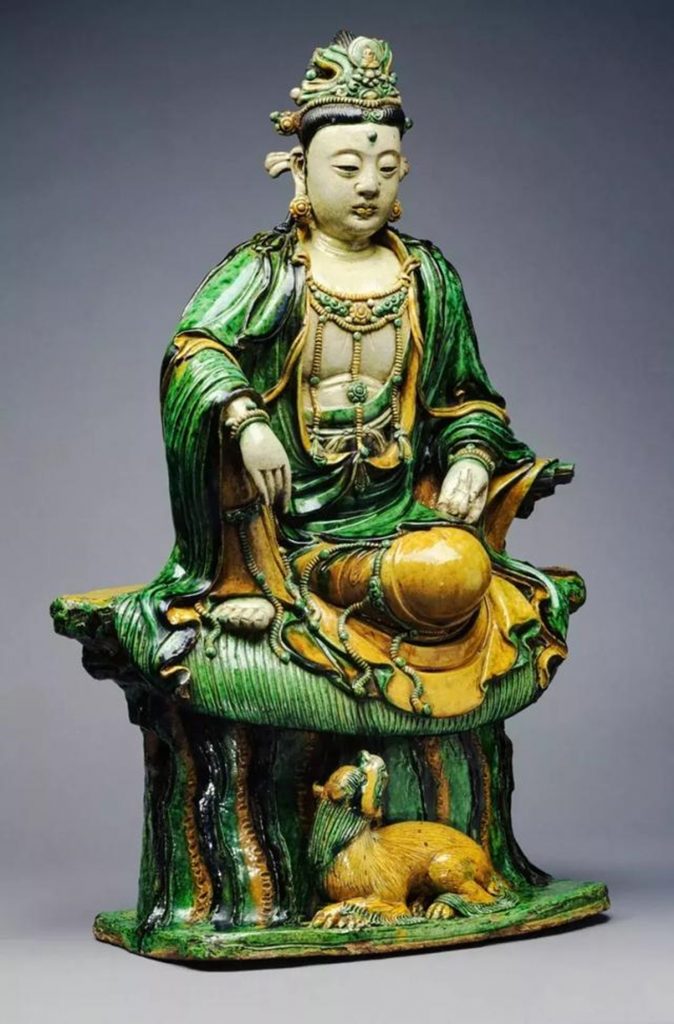
高68.5cm
底座背面共刻划三十四字:“杨城县南石里施主南张仪施弘治十三年本堂善人刘普明廉方本县东关匠人乔彬”,可知此为1500年乔家人乔彬所制。乔彬,活跃于明成化、弘治年间。
三彩中的“三”是为虚指,并非特定三种颜色。其器起源于北魏,盛行于唐,多为房屋构件或明器。辽代时曾经出现一批精美的三彩佛像,现今多流失海外。明代再次统一之后,社会安定,对器宇建设的需求大增,因此三彩器再次流行。明代中期,民间开始广泛出现三彩造像,或为庙宇供奉,或请入宅邸神龛,多形象生动,极为传神。
美国普林斯顿大学艺术博物馆藏有一尊高达68.5公分的观音三彩像,也刻有“本县东关匠人乔彬”的款识。乔家的釉陶烧造工艺一直传承至今。
Ming Dynasty 1500, Guanyin by Qiao Bin the younger, stoneware with sancai glaze. @The Princeton University Art Museum.
参考:
2011 | 現場拍賣 2862
重要中國瓷器及工藝精品
拍品 3767
A RARE MING SANCAI GLAZED STONEWARE FIGURE OF GUANYIN
明十六世紀
三彩觀音坐像
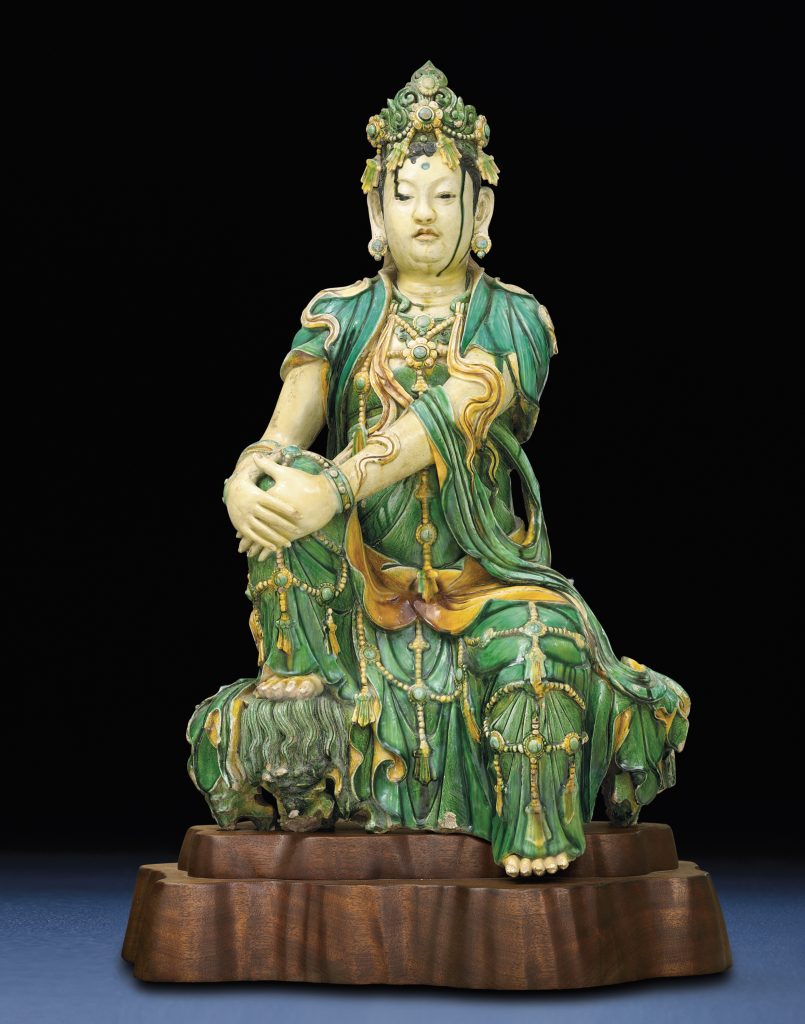
三彩觀音坐像
成交價HKD 4,580,000
估價HKD 2,200,000 – HKD 2,800,000
明十六世紀
三彩觀音坐像
明十六世紀 三彩觀音坐像
觀音高螺髻,戴寶冠,面目秀美,身著衣裙帔帛,胸腿飾瓔珞,垂左足,抬右腿曲於岩座上,雙手按右膝,姿勢自在輕鬆。佛像施綠、淡褐、黃三色釉,局部飾黑彩。
Avery Brundage收藏同式三彩菩薩像一尊,見1974年東京出版Rene-Yvon Lefevre d’Argence著《Chinese,Korean and Japanese Sculpture from the Avery Brundage Collection》,圖版170號,書中並論述很多三彩佛像源自山西省,巴黎吉美國立亞洲藝術博物館亦收藏近似的佛像一尊;Avery Brundage的藏品並表現紐約大都會博物館收藏的1494年製陶瓷佛像的風格,該原型見1947年紐約出版W.Cox著《The Book of Pottery and Porcelain》第一冊,圖版151號。
其他例子包括香港藝術館藏1617年製明代三彩佛像,見T. Nguyet及S. Markbreiter著「Hong Kong in Transition, Opening of the New Hong Kong Museum of Art」,載《Arts of Asia》,1991年11-12月,84頁。以及三彩菩薩像一對,進行熱釋光測試後定年十五世紀初製造,2002年10月28日於香港佳士得拍賣,拍品792號。
此像源於巴黎盧芹齋舊藏,後由倫敦Christopher Bruckner收藏,再經紐約Weisbrod Chinese Art Ltd售出,成為美國私人收藏。1988年11-12月Michael B. Weisbrod, Inc《Chinese Ceramic Art, Innovation and Imitation, from the Neolithic Period through the Qing Dynasty》展覽中展出,圖錄編號41。
來源
CT Loo, Paris
Christopher Bruckner, London
Weisbrod Chinese Art Ltd, New York
An American private collection
展覽
Chinese Ceramic Art, Innovation and Imitation, from the Neolithic Period through the Qing Dynasty, Michael B. Weisbrod, Inc., Nov./Dec. 1988, illustrated and discussed in the Catalogue by J. May Lee, no. 41
狀況報告
– There are areas of restoration to the hands and neck.
– There are other areas including parts of the face where the glaze has been stabilised.
– Surface chips to the lower extremities and drapery.
– The rear section of the lotus throne is missing.
– The condition is as would be expected of a ceramic figure of this size and age.
拍品專文
A related sancai-glazed seated figure of Buddha is illustrated by Rene-Yvon Lefevre d’Argence, Chinese, Korean and Japanese Sculpture from the Avery Brundage Collection, Kondasha, Tokyo, 1974, fig. 170. In the catalogue description, the author writes, “The figure belongs to a large series, many of which have reportedly come from Shansi, and is very close to a Buddha now in the Musee Guimet. The Avery Brundage Collection example seems to continue the style of a pottery Buddha, dated 1494, in the Metropolitan Museum of Art.” The dated figure in the Metropolitan Museum is illustrated by W. Cox, The Book of Pottery and Porcelain, Vol. 1, New York, 1947, pl. 151.
Compare also to several other massive sancai-glazed Ming figures, a Buddha dated 1617 in the Hong Kong Museum of Art, illustrated by T. Nguyet and S. Markbreiter, ‘Hong Kong in Transition, Opening of the New Hong Kong Museum of Art’, Arts of Asia, November-December 1991, p. 84; and a group of figures from the collection of Paul Huou Ming Tse, one of which is a Buddha, now in the Avery Brundage Collection, published by Paul Huou Ming Tse, Ta Kou Tchai, Preuves des Antiquites de Chine, Beijing, 1930. Two large standing figures of assistants to the Judge of Hell in the British Museum Collection, London are illustrated by J. Harrison-Hall, Ming Ceramics, London, 2001, pp. 541-543, nos. 19:3 and 19:4. Compare also a pair of sancai glazed figures of bodhisattvas dated to the early 15th century confirmed by the result of a thermoluminescence test, sold at Christie’s Hong Kong, 28 October 2002, lot 792.

![[临渊阁]天地一家春](https://www.antiquekeeper.ca/wp-content/uploads/2023/03/cropped-Asian-Art-Wallpaper-Painting3-6-3.jpg)

